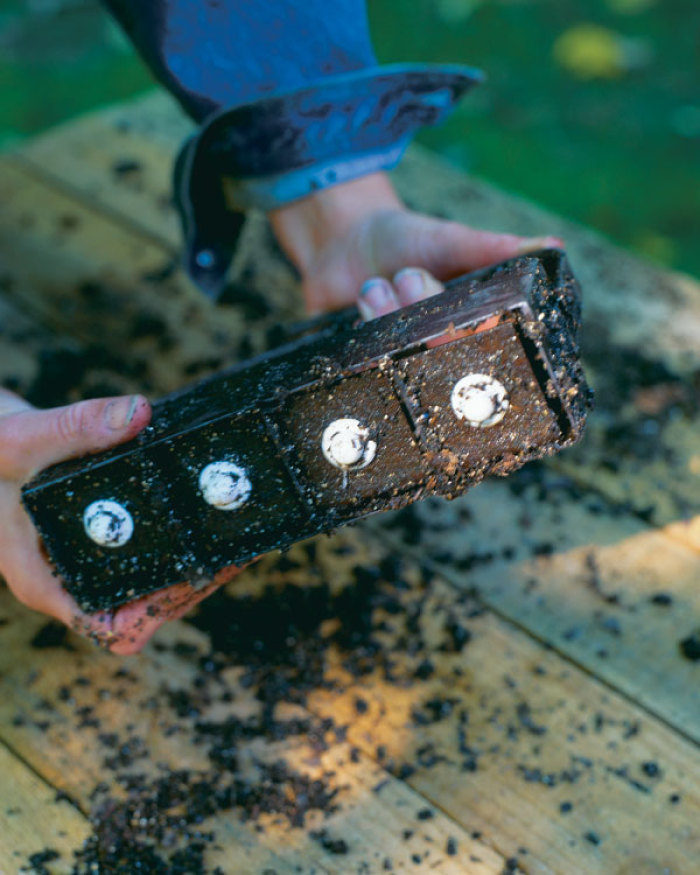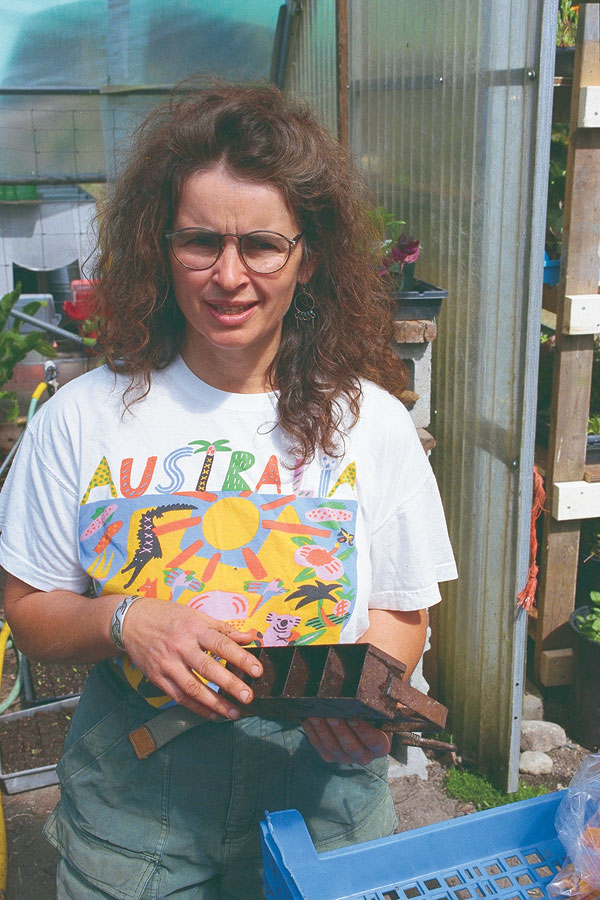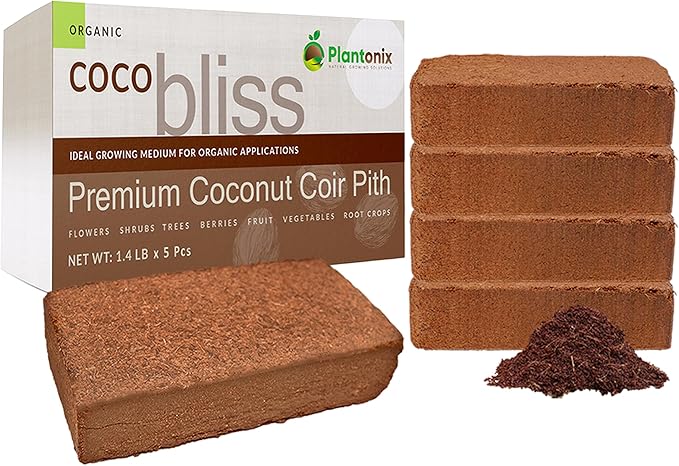Soil-Block Your Seeds
A nifty tool plus the right soil mix equals a bounty of seedlings

Back in 1989, while wandering the aisles of the Northwest Flower Show, suddenly I saw it: a fascinating implement with such appeal that I instantly gravitated toward it. After a long conversation with its owner, I purchased one, carefully packed it in my suitcase, and took it home to British Columbia. It was a soil blocker, and since then it has been my constant companion. I use it for all the indoor seed-starting at my organic market garden, and now, eight years after my purchase, I’m approaching my 200,000th soil block.
A soil blocker is a small, spring-loaded tool that shapes and ejects four 1-3/4-in. cubes of compressed potting mixture.
Using a soil blocker has a lot of advantages. For one, it’s a much cheaper way to start seedlings than buying either peat pots or those little expandable peat pellets. What’s more, it lets me prepare my own compost-based soil block mix or recipe. This not only costs less than buying a soil mixture, it also means I can control the content so I’m adding fertility to my garden every time I plant a block.
Learn more: Watch the Seed Starting Tips and Tricks Webinar
My soil-block maker, or soil blocker, is a small, spring-loaded tool that shapes and ejects four 1-3/4-in. cubes of compressed potting mixture. Each block has an indentation in the center of the top where you plant the seed. Blockers like mine cost $25 to $30 and are widely available from garden supply catalogs.
After experimenting over the years with different soil mixes, I’ve come up with one that works well for me. A number of the ingredients are close at hand in the garden or neighborhood and are usually free for the asking. If compost excites you, as it does me, here’s a project you’ll enjoy because compost is the main ingredient. There’s something energizing about the musty-smelling, crumbling “gold” and its promise of great things to come.
Soil recipe for seed-starting blocks
A good soil mixture must be fibrous enough to hold together through many waterings. I use a fine-grade peat moss to supply this “glue.” Sand is added to allow air to pass through and to improve drainage.
This is my recipe: 3 parts fine peat moss, 4 parts year-old compost, 1 part sand, 1/8 part dolomitic lime, and 3/4 part fertilizer mix made from 1 part rock phosphate, 1 part kelp meal, 1 part seed meal or blood meal, blended and aged for three months.
Mix the ingredients well in a wheelbarrow or pail. Add one part water to every three parts mix, making sure all peat moss and compost lumps are broken up. Let the mixture soak overnight.
If you’d rather buy a mixture for soil blocking, look for one that contains peat moss, perlite, lime, and an agent that retains moisture. The last ingredient is the most important, since the key to success with soil blocks is that they must be well drained but moisture retentive. You definitely want lime in the mixture to counteract the acidity of the peat.

|

|

|

|
Punching out the soil blocks
Now the fun begins. Your mixture should be like a paste. It’s better for it to be on the wet side; if it’s too dry, your blocks will crumble as they’re punched out. Excess water will be pressed out in the blocking process. Gather mesh trays or wooden flats or any containers that are easy to pull around in the garden when planting and that hold just enough blocks so they fit together tightly. This prevents the blocks from drying out too fast.
Plunge the blocker into the mixture, twisting as you push it down so the blocker will be as full as possible. An alternative method is to spread out a 3-in. to 4-in. heap of mix on a hard surface, and press the blocker into the mix. Then turn the blocker toward you, and use your fingers to add more mixture. Make sure each cube is filled tightly by pressing it against the palm of your hand. It is important for the blocker to be absolutely and firmly packed.
Scrape off any extra soil from the bottom of the blocker, and set the blocker in whatever container you’re using. Now, punch out your blocks. If they crumble, try adding more water to your mix.
Planting the seeds
I seed all my crops this way except for carrots, beans, and peas. Carrots don’t do well in soil blocks because of their long root, and beans and peas are easier and quicker to seed outside. I place one seed in the center of each block and leave the seed uncovered. For the crops I grow, I’ve found germination is greater when seeds aren’t covered. More oxygen reaches each seed.
Place the trays on a heated bench or, later in the season, in a protected place outdoors. Keep the blocks moist at all times. After the first true leaves appear, fertilize weekly with a manure tea or diluted liquid fish fertilizer.
One year, birds discovered a tasty lunch in my newly planted seed blocks, and the quail enjoyed a salad bar of juicy young lettuce. Now, I tuck row cover fabric like Reemay tightly around the flats to prevented unauthorized snacking.
Getting the block in the ground

For best results, plant your seedlings outdoors as soon as roots appear. Seedlings can hold on for a short time, however, as the roots are “air pruned,” and they will not become pot-bound. Plant the moist seedlings firmly in the garden soil, and water them well. Since the soil blocks retain water better than peat pots or pellets, no special care is needed after planting.
As the garden vegetables are plucked to eat, I replace the harvested items with new seedlings in their soil blocks. My almost whimsical purchase eight years ago has given me a practical way to a bountiful harvest, as well as the chance to spend hours in a productive process that also leaves my mind free to meditate and reflect. My soil blocker is the best bargain I ever found.
For links to articles, blog posts, and videos on starting vegetable and flower seeds, see Tips and Tricks for Starting Perennial and Vegetable Seeds
This article was originally published in Kitchen Gardener #7.
Fine Gardening Recommended Products

SHOWA Atlas 370B Nitrile Palm Coating Gloves, Black, Medium (Pack of 12 Pairs)
Fine Gardening receives a commission for items purchased through links on this site, including Amazon Associates and other affiliate advertising programs.

Coco Bliss 650gm Bricks (5-Pack) - Organic Coco Coir
Fine Gardening receives a commission for items purchased through links on this site, including Amazon Associates and other affiliate advertising programs.

Razor-Back Potato/Refuse Hook
Fine Gardening receives a commission for items purchased through links on this site, including Amazon Associates and other affiliate advertising programs.






Comments
Generally found this to be an informative article; however, the most useful section for me, the ‘recipe’ for a soil block mix is almost absurdly complex with its fractions. Please simplify for future readers!
Log in or create an account to post a comment.
Sign up Log in